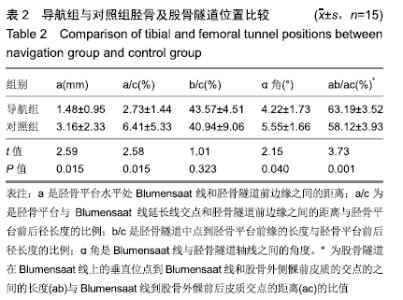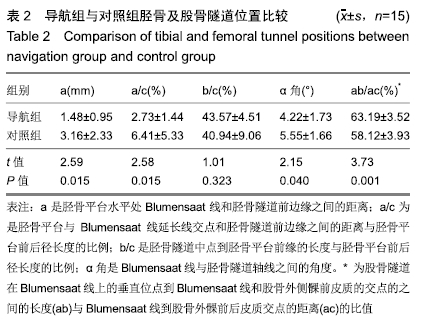Chinese Journal of Tissue Engineering Research ›› 2020, Vol. 24 ›› Issue (15): 2374-2380.doi: 10.3969/j.issn.2095-4344.2601
Previous Articles Next Articles
Accuracy of bone tunnel in anterior cruciate ligament reconstruction using electromagnetic navigation system
Jia Guoqing, Yu Zhiping, Hu Pengyu, Zhang Haiqing, Cong Haibo
- Department of Sports Medicine, Weihai Central Hospital Affiliated to Qingdao University, Weihai 264400, Shandong Province, China
-
Received:2019-09-26Revised:2019-09-28Accepted:2019-10-25Online:2020-05-28Published:2020-03-23 -
Contact:Cong Haibo, Chief physician, Professor, Master’s supervisor, Department of Sports Medicine, Weihai Central Hospital Affiliated to Qingdao University, Weihai 264400, Shandong Province, China -
About author:Jia Guoqing, Master candidate, Department of Sports Medicine, Weihai Central Hospital Affiliated to Qingdao University, Weihai 264400, Shandong Province, China -
Supported by:the Taishan Scholar Project Special Funding Project, No. ts201511110
CLC Number:
Cite this article
Jia Guoqing, Yu Zhiping, Hu Pengyu, Zhang Haiqing, Cong Haibo. Accuracy of bone tunnel in anterior cruciate ligament reconstruction using electromagnetic navigation system[J]. Chinese Journal of Tissue Engineering Research, 2020, 24(15): 2374-2380.
share this article

导航组胫骨平台水平处Blumensaat线和胫骨隧道前边缘之间的距离(a)为(1.48±0.95) mm,对照组为(3.16± 2.33) mm,差异有显著性意义(P=0.015);胫骨隧道的a长度与胫骨平台前后径的比值(a/c×%)和α角分别为(2.73± 1.44)%和(4.22±1.73)°,对照组分别为(6.41±5.33)%和(5.55±1.66)°,差异有显著性意义(P=0.015,0.040)。导航组所有胫骨隧道前缘位于Blumensaat线之后,且a距离、a/c×%和α角较对照组更小,这增加了胫骨隧道定位的准确性。 导航组胫骨隧道中点距胫骨平台前缘的平均距离为 28 mm,侧位片上平均位于胫骨平台的(43.57±4.51)% (b/c×%);对照组胫骨隧道中点距胫骨平台前缘的距离为 25 mm,位于胫骨平台的(40.94±9.06)% (b/c×%)。2组胫骨隧道位置差异无显著性意义(P=0.323),然而导航组胫骨隧道中心位置变化范围(38.1%-53.8%)略低于对照组(30.4%-56.4%),同时导航组a距离(0.1-3.2mm)的变化范围较对照组(-2.1-5.7mm)小,骨髓道定位更严格,增加了胫骨隧道定位的可重复性。 根据BERNARD等[19]的方法分析股骨隧道位置,所有导航组均在后上象限(4/4)的位置;对于对照组,在后上象限(4/4)有13例。对照组股骨隧道位置ab/ac×%= (58.12±3.93)%,股骨隧道的指数<60%;导航组股骨隧道位置平均ab/ac×%=(63.19±3.52)%,股骨隧道指数>60%;表明导航组股骨隧道位置更靠后(P=0.001),导航组相对偏后的股骨隧道可以更加保证膝关节的稳定性。 "

| [1] ENDELE D, JUNG C, BECKER U, et al. Anterior cruciate ligament reconstruction with and without computer navigation: a clinical and magnetic resonance imaging evaluation 2 years after surgery. Arthroscopy. 2009;25(10): 1067-1074. [2] BUSS DD, WARREN RF, WICKIEWICZ TL, et al. Arthroscopically assisted reconstruction of the anterior cruciate ligament with use of autogenous patellar-ligament grafts. Results after twenty-four to forty-two months. J Bone Joint Surg Am. 1993; 75(9): 1346-1355. [3] WIGER P, BRANDSSON S, KARTUS J, et al. A comparison of results after arthroscopic anterior cruciate ligament reconstruction in female and male competitive athletes. A two- to five-year follow-up of 429 patients. Scand J Med Sci Sports. 1999; 9(5): 290-295. [4] ABEBE ES, UTTURKAR GM, TAYLOR DC, et al. The effects of femoral graft placement on in vivo knee kinematics after anterior cruciate ligament reconstruction. J Biomech. 2011; 44(5): 924-929. [5] ZANTOP T, DIERMANN N, SCHUMACHER T, et al. Anatomical and nonanatomical double-bundle anterior cruciate ligament reconstruction: importance of femoral tunnel location on knee kinematics. Am J Sports Med. 2008; 36(4): 678-685. [6] KYUNG BS, KIM JG, CHANG M, et al. Anatomic double-bundle reconstruction techniques result in graft obliquities that closely mimic the native anterior cruciate ligament anatomy. Am J Sports Med. 2013; 41(6): 1302-1309. [7] BEDI A, ALTCHEK DW. The "footprint" anterior cruciate ligament technique: an anatomic approach to anterior cruciate ligament reconstruction. Arthroscopy. 2009; 25(10): 1128-1138. [8] KAWAKAMI Y, HIRANAKA T, MATSUMOTO T, et al. The accuracy of bone tunnel position using fluoroscopic-based navigation system in anterior cruciate ligament reconstruction. Knee Surg Sports Traumatol Arthrosc. 2012; 20(8): 1503-1510. [9] TENSHO K, KODAIRA H, YASUDA G, et al. Anatomic double-bundle anterior cruciate ligament reconstruction, using CT-based navigation and fiducial markers. Knee Surg Sports Traumatol Arthrosc. 2011; 19(3): 378-383. [10] COLOMBET PD, ROBINSON JR. Computer-assisted, anatomic, double-bundle anterior cruciate ligament reconstruction. Arthroscopy. 2008; 24(10): 1152-1160. [11] FERRETTI A, MONACO E, LABIANCA L, et al. Double-bundle anterior cruciate ligament reconstruction: a computer-assisted orthopaedic surgery study. Am J Sports Med. 2008; 36(4):760-766. [12] CHO WJ, KIM JM, KIM DE, et al. Accuracy of the femoral tunnel position in robot-assisted anterior cruciate ligament reconstruction using a magnetic resonance imaging-based navigation system: A preliminary report. Int J Med Robot. 2018; 14(5): e1933. [13] FORSYTHE B, COLLINS MJ, ARNS TA, et al. Optimization of anteromedial portal femoral tunnel drilling with flexible and straight reamers in anterior cruciate ligament reconstruction: a cadaveric 3-dimensional computed tomography analysis. Arthroscopy. 2017; 33(5):1036-1043. [14] MEUFFELS DE, REIJMAN M, VERHAAR JA. Computer-assisted surgery is not more accurate or precise than conventional arthroscopic ACL reconstruction: a prospective randomized clinical trial. J Bone Joint Surg Am. 2012; 94(17):1538-1545. [15] EGGERDING V, REIJMAN M, SCHOLTEN RJ, et al. Computer-assisted surgery for knee ligament reconstruction. Cochrane Database Syst Rev. 2014;(9):CD007601. [16] AHN JH, YANG HS, JEONG WK, et al. Arthroscopic transtibial posterior cruciate ligament reconstruction with preservation of posterior cruciate ligament fibers: clinical results of minimum 2-year follow-up. Am J Sports Med. 2006; 34(2): 194-204. [17] HIRAOKA H, KURIBAYASHI S, FUKUDA A, et al. Endoscopic anterior cruciate ligament reconstruction using a computer-assisted fluoroscopic navigation system. J Orthop Sci. 2006;11(2): 159-166. [18] HOWELL SM, TAYLOR MA. Failure of reconstruction of the anterior cruciate ligament due to impingement by the intercondylar roof. J Bone Joint Surg Am. 1993; 75(7): 1044-1055. [19] BERNARD M, HERTEL P, HORNUNG H, et al. Femoral insertion of the ACL. Radiographic quadrant method. Am J Knee Surg. 1997; 10(1): 14-21; discussion 212-212. [20] AGLIETTI P, BUZZI R, MENCHETTI PM, et al. Arthroscopically assisted semitendinosus and gracilis tendon graft in reconstruction for acute anterior cruciate ligament injuries in athletes. Am J Sports Med.1996;24(6):726-731. [21] FU FH, MUSAHL V. Review Article: The future of knee ligament surgery. J Orthop Surg (Hong Kong). 2001;9(2): 77-80. [22] GETELMAN MH, FRIEDMAN MJ. Revision anterior cruciate ligament reconstruction surgery. J Am Acad Orthop Surg. 1999;(3):189-198. [23] JALLIARD R, LAVALLEE S, DESSENNE V. Computer assisted reconstruction of the anterior cruciate ligament. Clin Orthop Relat Res.1998;(354):57-64. [24] JAGODZINSKI M, RICHTER GM, PASSLER HH. Biomechanical analysis of knee hyperextension and of the impingement of the anterior cruciate ligament: a cinematographic MRI study with impact on tibial tunnel positioning in anterior cruciate ligament reconstruction. Knee Surg Sports Traumatol Arthrosc. 2000; 8(1): 11-19. [25] FUSS FK. The restraining function of the cruciate ligaments on hyperextension and hyperflexion of the human knee joint. Anat Rec.1991;230(2):283-289. [26] CHENG T, ZHANG GY, ZHANG XL. Does computer navigation system really improve early clinical outcomes after anterior cruciate ligament reconstruction? A meta-analysis and systematic review of randomized controlled trials. Knee. 2012; 19(2): 73-77. [27] PLAWESKI S, ROSSI J, MERLOZ P, et al. Analysis of anatomic positioning in computer-assisted and conventional anterior cruciate ligament reconstruction. Orthop Traumatol Surg Res. 2011;97(6 Suppl): S80-85. [28] YOON KH, KIM JS, KIM SJ, et al. Eight-year results of transtibial nonanatomic single-bundle versus double-bundle anterior cruciate ligament reconstruction: Clinical, radiologic outcomes and survivorship. J Orthop Surg (Hong Kong). 2019; 27(2): 2309499019840827. [29] VOLPI P, QUAGLIA A, CARIMATI G, et al. Double bundle anterior cruciate ligament reconstruction: Failure rate and patients-reported outcomes at 4-11 years of follow up. J Orthop. 2019;16(3): 224-229. [30] LI Y J, ZHANG MC, LIU M, et al. [Femoral tunnel positioning in posterior cruciate ligament double-bundle reconstruction by computer aided design]. Zhongguo Gu Shang. 2015; 28(2): 162-167. [31] COLOMBET P, ROBINSON J, CHRISTEL P, et al. Using navigation to measure rotation kinematics during ACL reconstruction. Clin Orthop Relat Res. 2007;454: 59-65. [32] ZANTOP T, HERBORT M, RASCHKE MJ, et al. The role of the anteromedial and posterolateral bundles of the anterior cruciate ligament in anterior tibial translation and internal rotation. Am J Sports Med. 2007;35(2): 223-227. |
| [1] | Zhang Tongtong, Wang Zhonghua, Wen Jie, Song Yuxin, Liu Lin. Application of three-dimensional printing model in surgical resection and reconstruction of cervical tumor [J]. Chinese Journal of Tissue Engineering Research, 2021, 25(9): 1335-1339. |
| [2] | Liu Shaohua, Zhou Guanming, Chen Xicong, Xiao Keming, Cai Jian, Liu Xiaofang. Influence of anterior cruciate ligament defect on the mid-term outcome of fixed-bearing unicompartmental knee arthroplasty [J]. Chinese Journal of Tissue Engineering Research, 2021, 25(6): 860-865. |
| [3] | Li Chenjie, Lü Linwei, Song Yang, Liu Jingna, Zhang Chunqiu. Measurement and statistical analysis of trabecular morphological parameters of titanium alloy peri-prosthesis under preload [J]. Chinese Journal of Tissue Engineering Research, 2021, 25(4): 516-520. |
| [4] | Ma Ziyue, Ju Xiaochen, Zhang Lei, Sun Rongxin. Tendon-bone healing in anterior cruciate ligament reconstruction with and without remnant preservation [J]. Chinese Journal of Tissue Engineering Research, 2021, 25(4): 582-587. |
| [5] | Zhang Yu, Feng Shuo, Yang Zhi, Zhang Ye, Sun Jianning, An Lun, Chen Xiangyang. Three-dimensional gait of patients with developmental dysplasia of hip undergoing total hip arthroplasty with high hip center [J]. Chinese Journal of Tissue Engineering Research, 2021, 25(3): 350-355. |
| [6] | He Jie, Chang Qi. Biological reconstruction of large bone defects after resection of malignant tumor of extremities [J]. Chinese Journal of Tissue Engineering Research, 2021, 25(3): 420-425. |
| [7] | Zhou Jihui, Li Xinzhi, Zhou You, Huang Wei, Chen Wenyao. Comparison of the advantages and disadvantages of multiple implants in treatment of traumatic dislocation of sternoclavicular joint [J]. Chinese Journal of Tissue Engineering Research, 2021, 25(3): 443-448. |
| [8] | Xie Jingshu, Zhang Xianglin, Liu Jinlei, Wen Jing. Application of High Resolution reconstruction algorithm in precision CT scans of the middle and inner ears [J]. Chinese Journal of Tissue Engineering Research, 2021, 25(23): 3614-3618. |
| [9] | Wang Shengjun, Yin Fei, Jiang Maoyu. Application of titanium ossicular prosthesis in one-stage open tympanoplasty for middle ear cholesteatoma [J]. Chinese Journal of Tissue Engineering Research, 2021, 25(22): 3505-3509. |
| [10] | Chen Jie, Liao Chengcheng, Zhao Hongbo, Zhao Wei, Chen Zhiwei, Wang Yan. Application of tissue engineering urethral stent and its preparation technology in urethral reconstruction [J]. Chinese Journal of Tissue Engineering Research, 2021, 25(22): 3591-3596. |
| [11] | Xiong Xiaolong, Wang Guangji, Fang Yehan, Du Xiufan, Hang Hui, Ye Zhifang. Meta-analysis of comparison of the effect of tibial fixation using absorbable screws and metal screws in anterior cruciate ligament reconstruction with autologous hamstrings [J]. Chinese Journal of Tissue Engineering Research, 2021, 25(21): 3438-3444. |
| [12] | Lu Mingfeng, Zhao Lilian, Xing Jisi, He Lilei, Xu Ting, Wang Changbing. Posttraumatic progression of cartilage degeneration following anterior cruciate ligament reconstruction: a second-look arthroscopic analysis [J]. Chinese Journal of Tissue Engineering Research, 2021, 25(2): 222-227. |
| [13] | Zheng Weipeng, Wei Hewei, Liu Zhijun, Wan Lei, Chen Sheng, Liao Zhihao, Hu Weijian. Application of three-dimensional reconstructive CT versus X-ray in postoperative evaluation of bone tunnel and graft status after single bundle anterior cruciate ligament near-isometric reconstruction [J]. Chinese Journal of Tissue Engineering Research, 2021, 25(18): 2881-2886. |
| [14] | Han Shichong, Li Chang, Xing Haiyang, Ge Wenlong, Wang Gang . Finite element analysis of two internal fixation methods for treating extra-articular proximal tibial fractures [J]. Chinese Journal of Tissue Engineering Research, 2021, 25(15): 2329-2333. |
| [15] | Sun Kai, Chen Lei, Mai Yao, Hu Hua, Chen Liang, Zhong Jun, Hu Yong, Qiu Bo. Clinical application of enhanced recovery after surgery in the perioperative period of anterior cruciate ligament reconstruction [J]. Chinese Journal of Tissue Engineering Research, 2021, 25(11): 1647-1651. |
| Viewed | ||||||
|
Full text |
|
|||||
|
Abstract |
|
|||||

